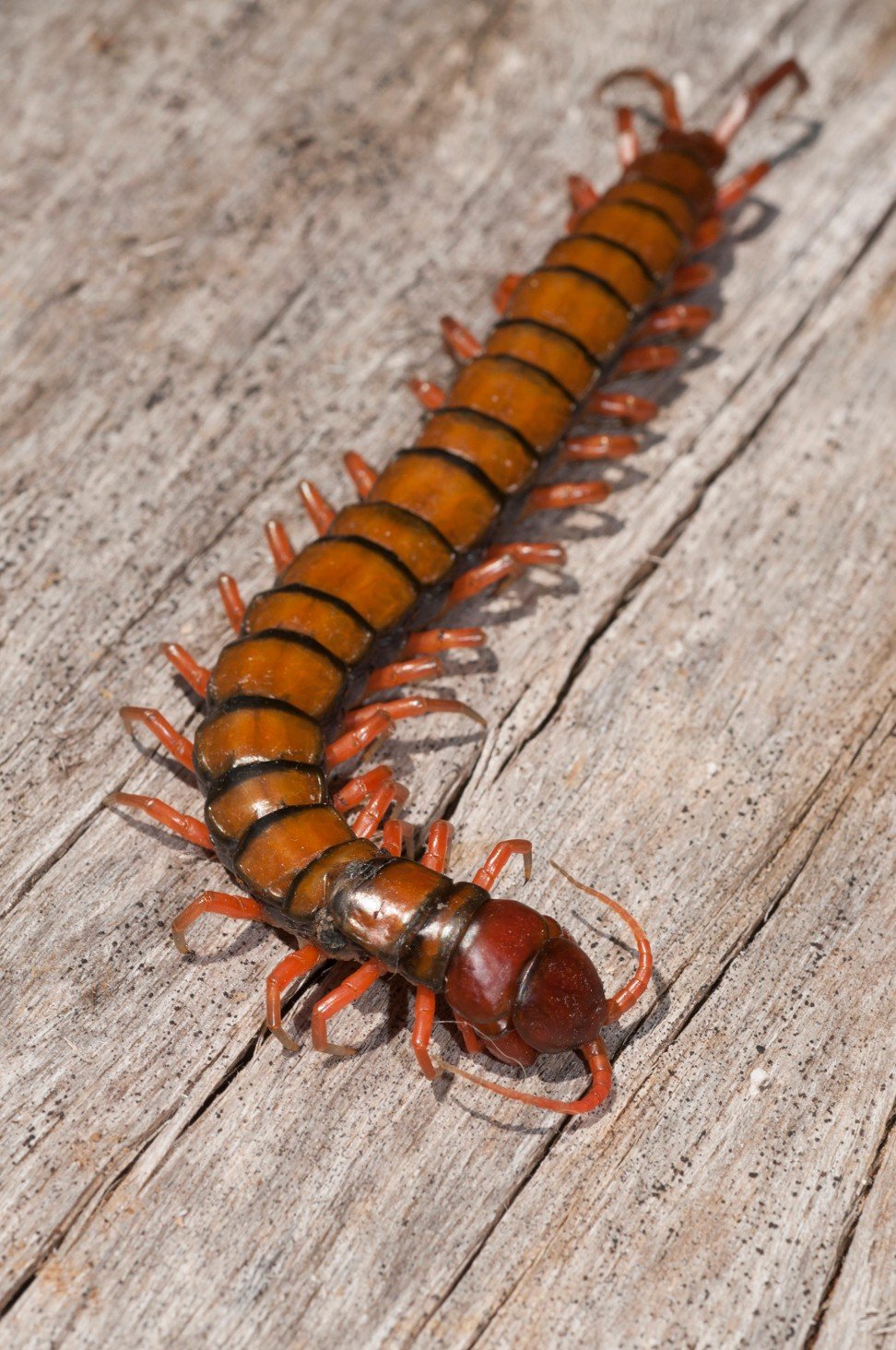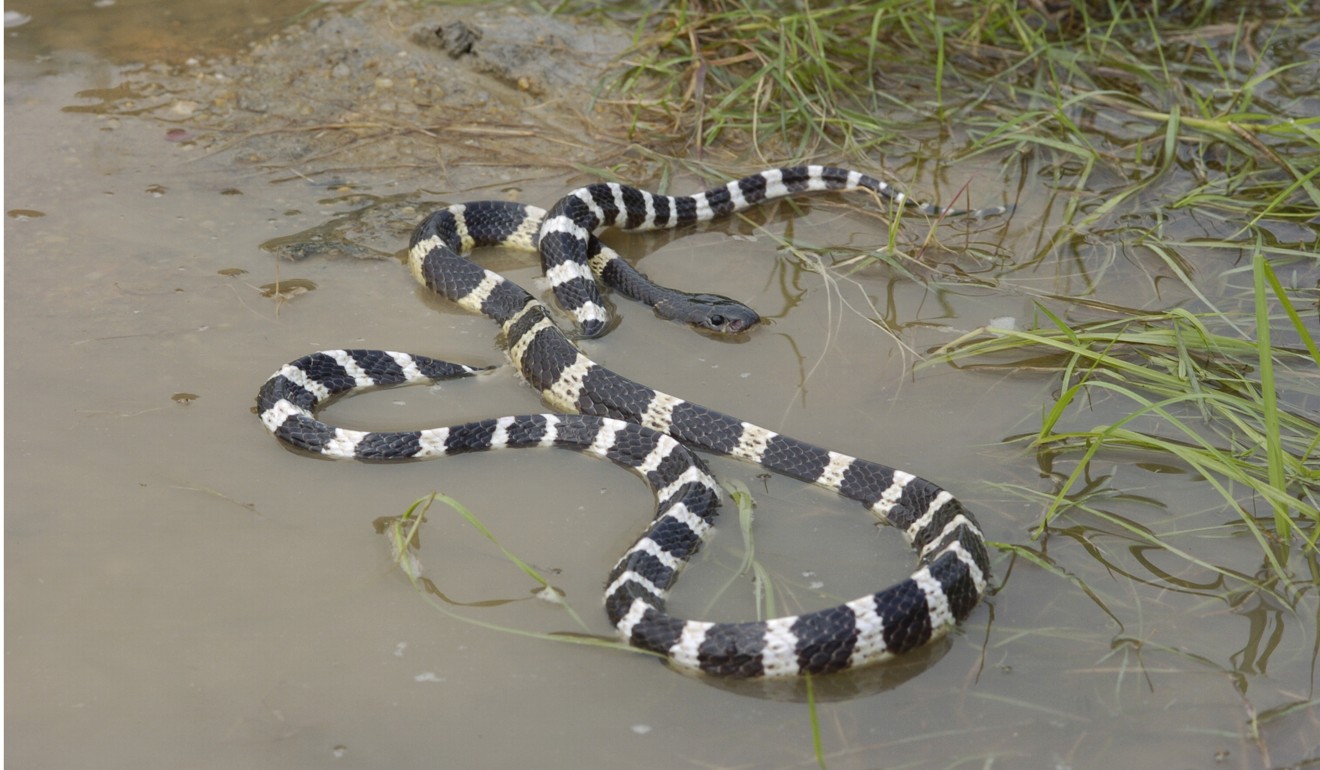
Hong Kong has its fair share of formidable wildlife that can inflict serious harm if disturbed or provoked. And it’s not just snakes that are more active during the hotter months of summer; Hong Kong is home to a highly toxic toad, a monster hornet that can leave gaping wounds, and even a seemingly docile octopus with a lethal payload.
William Sargent, an ecologist based on Lantau Island, says that although venomous creatures tend to be more fearsome, people should still have respect for them. “Every animal has a critical role in highly integrated food webs, and if you don’t respect one part of that web, you are not respecting nature as a whole,” Sargent says.
Here are some of the venomous creatures to watch out for in Hong Kong.

Giant centipede
Prone to invading homes in rural areas of Hong Kong, the giant centipede grows up to 13cm in length. So it’s hard to miss until it bolts under the bed out of sight.
These centipedes runs rapidly and their venom is a potent neurotoxin. They are able to kill prey 15 times larger than themselves, including mice, according to the American Association for the Advancement of Science.
“Centipede venoms pack a serious punch – causing rapid paralysis in lizards, cockroaches, and other animals unlucky enough to be on the invertebrate’s menu,” the association says.
Fortunately, although the predator’s bite typically causes pain and swelling in humans, it may require a visit to the hospital but not the morgue.

Asian common toad
One of the most widespread amphibian species in Hong Kong is the Asian common toad – also called the common Sunda toad, black-spined toad or black-spectacled toad. The creature is armed with kidney-shaped glands on its cheeks that contain a milky fluid poisonous to the mammals, birds, and snakes that prey on it. So humans would do well to avoid the mottled, warty animal to be found near ponds, pools and rivers.

Lion’s mane jellyfish
The lion’s mane is the world’s largest known jellyfish. Some specimens measure as much as 2.4 metres in diameter and 36.5 metres in length – about seven metres longer than the longest known blue whale, says Britannica.com
According to the local blog HK Marine Life, administered by a marine biologist, the jellyfish begins arriving in late March and numbers peak in midsummer. The visitor subdues prey with its tentacles, which are studded with stinging cells that contain neurotoxins. It feeds on a wealth of organisms: small fishes, comb jellies, zooplankton, even other jellyfish. People who tangle with the animal experience a nasty burning sensation.

Pufferfish
The name pufferfish derives from its ability to boost its size by inflating its body. The stunning accomplishment that involves sucking water into a chamber near the stomach serves as a defence mechanism. After a puffer fish has ballooned, predators find it even more difficult to eat the spined creature, which packs a poison called tetrodotoxin that makes it potentially lethal.
A single pufferfish contains enough poison to kill 30 adult humans and no known antidote exists. That is why the Japanese pufferfish delicacy known as fugu demands meticulous preparation. If poison is ingested, symptoms arise after between 10 and 45 minutes, starting with tingling around the mouth. Symptoms may advance to paralysis, blackout, and respiratory failure, potentially resulting in death.

Blue-ringed octopus
The blue-ringed octopus shows its trademark coloured markings when disturbed. However, those markings meant to serve as a warning may have the reverse effect on some beachgoers, in particular, children, who may find it beguiling.
If touched, a blue-ringed octopus may bite in self-defence. While painless, the bite’s impact can prove fatal because its venom carries tetrodotoxin – like the pufferfish.

Asian giant hornet
The Asian giant hornet is the world’s largest, with workers growing to a length of almost 4cm. Queens usually top that size. In contrast to bees’ stingers, the hornet’s lacks a barb, meaning it can strike repeatedly without its lance dropping off.
The venom delivered can dissolve human flesh and overburden the kidneys. Running away is unlikely to help because giant hornets fly at up to 24km/h. The hornet made world news in 2013 when a swarm killed 42 people in Shaanxi province. Survivors’ injuries were like bullet holes and they suffered kidney damage that is liable to last a lifetime.

Coral snake
Russet with black stripes, the coral snake is “extremely venomous”, according to the reptile database of the School of Biological Sciences at University of Hong Kong. HKU adds that it delivers a potent neurotoxic venom and is known to have caused some human fatalities in Thailand.
Widely but thinly distributed, the snake can be found on Hong Kong Island, Lantau Island and in the central New Territories.
How Hongkongers can lose their fear of snakes, one selfie at a time
Despite its name, the coral snake is a hillside species that inhabits forests and grassland. During the day, it conceals itself in forest floor leaf litter and loose soil. Nocturnal, it is secretive, inoffensive, indeed “rather tame”, HKU says. But its venom still makes it highly dangerous.

Chinese cobra
The sleek and stocky Chinese cobra has distinctive marking – an insignia-like monocle on its hood. About a metre long, it occupies a range of habitats: shrub land, grassland, woodland and mangrove swamps.
In August 2017, Hong Kong snake catcher David Willott was struck by one during a call-out to a back garden in Tai Wan village, Sai Kung. “As I tried to tie the top of the bag, I felt some pain,” he said. “I thought it was a staple from the bag.”
When Willott got to hospital doctors gave him antivenom and he discharged himself after a 24-hour stay. But after just 10 hours, he returned to have part of his blackening finger removed. Meantime, he felt nauseous because of the venom, which could eventually have derailed his central nervous system and killed him.

King cobra
The world’s longest venomous snake, the king cobra occurs throughout Hong Kong and feeds on other, smaller snakes. The Agriculture, Fisheries and Conservation Department rates it as lethal. The predator’s toxic venom can be injected in considerable amounts because of its size. Generally, however, the king cobra is timid. It keeps clear of humans unless approached while protecting its nest.
In such circumstances, the king cobra may become highly defensive. According to herpetologists, its bite can kill a human in 15 minutes and a full-grown elephant in several hours.

Many-banded krait
With its alternating black and white stripes, the many-banded krait looks menacing and lives up to its image. According to HKU, it is “extremely venomous”. Deceptively, its bite just causes mild itching. Nonetheless, delayed treatment can be fatal, HKU says. Its potent neurotoxic payload attacks the nervous system, causing respiratory paralysis and possible heart failure.
Housing or rare butterflies? Hong Kong green group says country park eyed by officials is a wildlife haven
According to Sargent, the many-banded krait is by far the most toxic snake in Hong Kong and fourth in the world among species of land snakes. The 1.2-metre predator occurs in a range of habitats including forest, shrub land, and the fringes of mangroves but favours marshy spaces.

Textile cone shell
One of the commonest cone shells in Hong Kong waters, the sea snail’s orange shell features wavy chocolate lines. Like the coral snake and blue-ringed octopus, the reef predator is visually attractive, however it is armed with a harpoon-like venomous tooth. “The venom is designed to paralyse, however not much is needed for it to kill fish, or humans,” writes ABC journalist Matt Watson.
Several human deaths have resulted from handling, HK Marine Life says, branding the cone shell “beautiful but deadly”. Typical symptoms include numbness, tingling and sharp pain. Severe cases bring about double vision, muscle paralysis, and respiratory paralysis preceding death.







